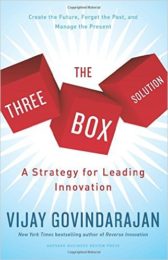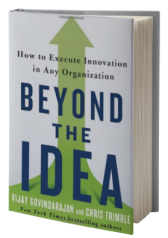Extending Corporate Purpose Beyond Profit Maximization to Serving Multiple Stakeholders
Digital Transformation of Asset-Heavy Industrials like General Motors, John Deere, and Rolls Royce
Transformation of Higher Education
Strategy is Innovation
Securing global presence is anything but synonymous with possessing global competitive advantage. Presence in strategically important markets is certainly a precondition for creating global competitive advantage. To convert global presence into global...
Securing global presence is anything but synonymous with possessing global competitive advantage. Presence in strategically important markets is certainly a precondition for creating global competitive advantage. To convert global presence into global competitive advantage, the company must pursue three value creation opportunities: adapting to local market differences, exploiting economies of global scale, and maximizing the knowledge transfer across borders. Pursuing these value creation opportunities requires the firm to design the right type of organization (in terms of structure, systems, people, process, and culture), an organization that can simultaneously optimize local responsiveness, global scale, and knowledge transfer.
Learn More
Reverse Innovation
In this Reverse Innovation Module, VG introduces the idea of developing in emerging markets first – instead of scaling down rich-world products – to unlock a world of opportunities for your business. Stemming from a pivotal article in Harvard ...
In this Reverse Innovation Module, VG introduces the idea of developing in emerging markets first – instead of scaling down rich-world products – to unlock a world of opportunities for your business. Stemming from a pivotal article in Harvard Business Review, his reverse innovation presentation offers an important next step for companies looking to derive long-term value from emerging markets. According to VG, “Reverse innovation is a potent force that will transform the global economy over the next few decades. It will redistribute power and wealth to countries and companies who understand it and diminish those who do not.”
VG offers a glimpse at strategies from some of the world’s leading companies – from GE and Deere & Company to P&G and PepsiCo. There is no one industry that needs to reverse innovate; instead, all industries must have interest in the needs and opportunities in the developing world in order to thrive in tomorrow’s global marketplace.
Learn More
Innovation Execution: Executing the Box 3 Strategies
Implementing Box 3 breakthrough innovation projects is the triple-flip-with-a-quadruple-twist of general management. No matter how talented and experienced the leader, chances are that this is a new and unfamiliar challenge. VG can help you understand the three fundamental ...
Implementing Box 3 breakthrough innovation projects is the triple-flip-with-a-quadruple-twist of general management. No matter how talented and experienced the leader, chances are that this is a new and unfamiliar challenge. VG can help you understand the three fundamental challenges faced by Box 3 strategic experiments, and can offer several specific recommendations to help you overcome them.
Learn More
Delivering World-class Healthcare, Affordably
In this presentation, VG explains how innovative Indian hospitals are delivering high-quality healthcare at prices 95% below American hospitals. Although the context is very different in these two countries, there are lessons that U.S. healthcare leaders can learn and apply....
In this presentation, VG explains how innovative Indian hospitals are delivering high-quality healthcare at prices 95% below American hospitals. Although the context is very different in these two countries, there are lessons that U.S. healthcare leaders can learn and apply.
To provide high-quality care at ultra-low costs, private Indian hospitals have adopted three techniques: 1) hub-and-spoke networks; 2) task shifting; and 3) basic frugality. These approaches enable these hospitals to maximize the number of patients served, while benefiting from economies of scale. In the years ahead, U.S. healthcare providers should learn about and consider adopting these principles as they strive to expand access, improve quality, and reduce costs. If U.S. providers don’t change, they actually risk being disrupted by these efficient, low- cost Indian providers.
Learn More
THREE-BOX SOLUTION
We now live in an era of constant change, driven by the dynamic forces of technology, globalization, the Internet, changing demographics, and shifting customer preferences. As a result, companies find that their strategies need almost constant redefinition—either because the...
We now live in an era of constant change, driven by the dynamic forces of technology, globalization, the Internet, changing demographics, and shifting customer preferences. As a result, companies find that their strategies need almost constant redefinition—either because the old assumptions are no longer valid, or because the previous strategy has been imitated and neutralized by competitors. Rooted in these premises, the strategic and organizational challenges become:
• How do we identify the market discontinuities that could transform our industry?
• How can we create new growth platforms that exploit new market realities?
• What are our core competencies and how can we leverage them to generate growth?
• What new core competencies do we need to build?
• What organizational DNA will allow us to anticipate and respond to changes on a continual basis?
• How do we execute breakthrough strategies?
Learn More




